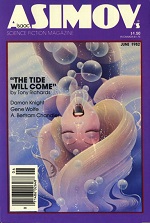|  
 
 
 
 
 
 
 
 
 
 
 
 
 
 
 | | | |  | | “Azimuth 1,2,3...”
by Damon Knight
First publication: Asimov’s Science Fiction, Jun 1982

Shortly after genius Azimuth Backfiler (yes, that’s his real name) finds a way to travel back in time, Azimuth 2 appears and hands him next week’s newspaper causing some sort of feedback that create Azimuth 3, Azimuth 4, . . . Therefore, he was not surprised to see himself emerge from the chamber, wearing this very suit, a moment after he had formed the decision. Therefore, he was not surprised to see himself emerge from the chamber, wearing this very suit, a moment after he had formed the decision. 
| |
| | | | |

 
 
 
 
 
 
No Time Travel. Move along. |
Port Eternity by C.J. Cherryh, 1982 [parallel universe ]
aka Involutions

Voyage from Yesteryear by James P. Hogan, Apr 1982 [despite title, no time travel ]

“Lazarus Rising” by Gregory Benford, Asimov’s, Jul 1982 [long sleep ]

“The Boy Who Waterskied to Forever” by James Tiptree, Jr., F&SF, Oct 1982 [no definite time travel ]

“Dr. Time” by Sharon N. Farber, et. al., Asimov’s, Oct 1982 [despite title, no time travel ]

| |     |